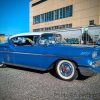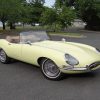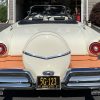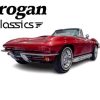1917 Rauch & Lang Electric BX7 Brougham
Description
This 1917 Rauch & Lang BX7 is a five-passenger Brougham that was manufactured by the Baker R&L Company in Cleveland, Ohio, and was purchased by its current owner in 2021. Wearing an older refurbishment in two-tone blue over blue cloth, the car is powered by a Hertner electric motor that provides five forward speeds to the rear wheels via a cardan shaft and a worm-drive axle. Additional features include 12 six-volt batteries with an onboard charging system, rear-seat controls with tiller steering, internally expanding rear drum brakes, mechanical and electric driveline brakes, leaf-spring suspension, artillery wheels wearing 33×4½” pneumatic tires, vis-à-vis seating, a combination gauge, and a Waltham eight-day clock. This Rauch & Lang BX7 is now offered on dealer consignment in St. Louis, Missouri, with a clean Wisconsin title listing it as a 1916 model. Incorporated in the 1880s as a carriage and wagon maker, Rauch & Lang began development of their own electrically propelled vehicles in 1904 after experimenting with the sale of Buffalo Electric cars from their showrooms. Rauch & Lang absorbed motor and controller supplier Hertner Electric in 1907 and by 1908 was producing 500 cars a year in a range of open and closed body configurations. After the advent of the electric starter for gasoline engines dampened enthusiasm for electric vehicles, the company merged with Cleveland competitor Baker Electric in 1915 and continued to offer several passenger models under the Rauch & Lang brand over the remainder of the decade. Riding on a 92” wheelbase, this example’s aluminum Brougham coachwork wears an older repaint in two-tone blue. Areas of paint blistering are noted ahead of the left-side door, on the right rear and left front of the body, and on the front battery compartment cover. Features include rear-hinged doors, curved side windows, a pop-out upper windshield panel, a textured fabric roof, running boards, nickel-rimmed headlights, and twin cowl lamps. A scuff is present on the roof covering. The 24” wood-spoke wheels are finished in black with white pinstriping and wear 33×4½” white pneumatic tires that are said to have been mounted two years ago. Stopping is handled by pedal-actuated internally expanding shoes at the rear wheels, while the control lever engages a mechanical brake contracting on the armature shaft and an electric brake that short-circuits the armature. The cabin features a rear bench that seats the driver on its left side as well as two front bucket seats that swivel to face rearward for a parlor-style arrangement. Blue cloth covers the seats, door panels, and side panels and is complemented by a color-keyed headliner and carpeting. Features include roll-up windows, a rearview mirror spanning the width of the windshield, rear corner lights, and an overhead dome light, the latter of which is designed to illuminate upon opening of the doors but does not work. An area of wear is visible on the fabric adjacent to the left-side window winder, and the warning bell does not work. Rear-operated controls include a foldaway steering tiller, a control lever with a lock and safety cut-out switch, and a floor-mounted pedal for selection of reverse operation. A combination gauge mounted between the front seats incorporates gauges monitoring amperage hours, amperage, and voltage as well as a Warner Auto-Meter drum-style speedometer. The four-digit odometer shows 6k miles, approximately 25 of which have been added under current ownership. The gauge lighting does not work. A Waltham eight-day clock is situated on the front cowl. The Hertner DC motor drives a cardan shaft that transfers power to the rear wheels via a worm gear atop the rear axle housing. Suspension incorporates solid front and rear axles with elliptical leaf springs at the rear and semi-elliptical leaves at the front. Twelve six-volt Interstate batteries are wired in series and are divided between the front and rear compartments in lieu of the car’s original 41-cell power-supply arrangement. A Schumacher multi-battery charger is housed in the front compartment. The Wisconsin title identifies the car by its body number, 570, which is stamped on the chassis plate above.














































